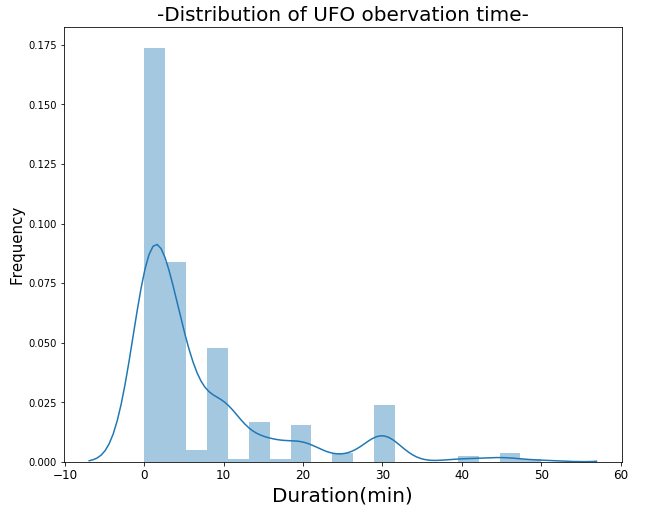Pandas Datetime: Create a plot of distribution of UFO observation time
Pandas Datetime: Exercise-20 with Solution
Write a Pandas program to create a plot of distribution of UFO (unidentified flying object) observation time.
Sample Solution:
Python Code:
import pandas as pd
import matplotlib.pyplot as plt
import seaborn as sns
df = pd.read_csv(r'ufo.csv')
df['duration_sec'] = (df['length_of_encounter_seconds'].astype(float))/60
s = df["duration_sec"].quantile(0.95)
temp = df['duration_sec']
temp = temp.sort_values()
temp = temp[temp < s]
plt.figure(figsize=(10, 8))
sns.distplot(temp)
plt.xlabel('Duration(min)', fontsize=20)
plt.ylabel("Frequency", fontsize=15)
plt.xticks(fontsize=12)
plt.title("-Distribution of UFO obervation time-", fontsize=20)
plt.show()
Sample Output:
C:\Users\User\Anaconda3\lib\site-packages\scipy\stats\stats.py:1713: FutureWarning: Using a non-tuple sequence for multidimensional indexing is deprecated; use `arr[tuple(seq)]` instead of `arr[seq]`. In the future this will be interpreted as an array index, `arr[np.array(seq)]`, which will result either in an error or a different result. return np.add.reduce(sorted[indexer] * weights, axis=axis) / sumval
Python Code Editor:
Have another way to solve this solution? Contribute your code (and comments) through Disqus.
Previous: Write a Pandas program to check the empty values of UFO (unidentified flying object) Dataframe.
Next: Write a Pandas program to create a graphical analysis of UFO (unidentified flying object) sighted by month.
What is the difficulty level of this exercise?
Python: Tips of the Day
Find current directory and file's directory:
To get the full path to the directory a Python file is contained in, write this in that file:
import os dir_path = os.path.dirname(os.path.realpath(__file__))
(Note that the incantation above won't work if you've already used os.chdir() to change your current working directory, since the value of the __file__ constant is relative to the current working directory and is not changed by an os.chdir() call.)
To get the current working directory use
import os cwd = os.getcwd()
Documentation references for the modules, constants and functions used above:
- The os and os.path modules.
- The __file__ constant
- os.path.realpath(path) (returns "the canonical path of the specified filename, eliminating any symbolic links encountered in the path")
- os.path.dirname(path) (returns "the directory name of pathname path")
- os.getcwd() (returns "a string representing the current working directory")
- os.chdir(path) ("change the current working directory to path")
Ref: https://bit.ly/3fy0R6m
- New Content published on w3resource:
- HTML-CSS Practical: Exercises, Practice, Solution
- Java Regular Expression: Exercises, Practice, Solution
- Scala Programming Exercises, Practice, Solution
- Python Itertools exercises
- Python Numpy exercises
- Python GeoPy Package exercises
- Python Pandas exercises
- Python nltk exercises
- Python BeautifulSoup exercises
- Form Template
- Composer - PHP Package Manager
- PHPUnit - PHP Testing
- Laravel - PHP Framework
- Angular - JavaScript Framework
- Vue - JavaScript Framework
- Jest - JavaScript Testing Framework
